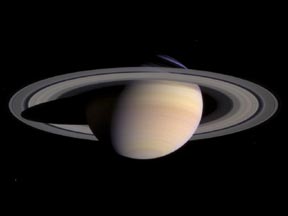
The goal of the systemic research collaboration is to improve our statistical understanding of the galactic planetary census. This will be accomplished through a large-scale simulation in which the public is invited to participate.
At the core of the systemic simulation, we have generated a realistic catalog that contains 100,000 stars, and we have created planetary systems in orbit around some of these stars. As the collaboration unfolds, the systemic catalog of stars will be “observed” using a realistic model of the radial velocity technique, and a radial velocity data set for each star will be made available. Participants will use the systemic console (or their own software if they choose) to discover and characterize planets within the data sets.
The measured orbital properties and distributions of the planets that are uncovered in the systemic data sets will eventually be compared with the known properties of the planets that were placed into orbit around the systemic catalog stars.
Why the name systemic?
We have four answers: (1) The collaboration utilizes a planetary system integrator console. (2) We are seeking to better understand the statistical distribution of planetary system initial conditions in the galaxy. (3) We hope that the collaboration will make the analysis of extrasolar planetary systems more evident, “Ahh, now I see!” (4) Finally, and most importantly, the planetary systems that we have designed are fully internally consistent. (More on this later.)
The project will officially start in early 2006. In the meantime, we have released a beta version of the systemic console, along with three tutorials (1, 2, and 3). The www.oklo.org site is also a weblog where we’ve been posting a variety of articles on the topic of extrasolar planets and their detection and characterization.
Currently, the systemic console has access to a number of published radial velocity data sets for real stars containing known planetary systems. We have also added the first star of the systemic catalog (which coincidently shows definite indications of harboring a planetary system). Launch the console, choose systemic001 from the system menu, and use the comment space for this post to let us know what you find!
— The Systemic Team,
Greg Laughlin — UC Santa Cruz
Stefano Meschiari — University of Bologna
Eugenio Rivera — UC Santa Cruz
Paul Shankland — US Naval Observatory
Aaron Wolf — UC Santa Cruz

For those who want to use their own fitting routines, the first 136 radial velocities of the “systemic 001” radial velocity data set are listed below in ASCII format. Note that (as is the case with real systems) the radial velocity errors are those imposed by the radial velocity technique, and do not include the unknown stellar jitter. One can assume in this case that the one-solar mass parent star is no more or less active than other similar old G-type main sequence dwarfs. Days are relative to HJD 2453520.0549. Apologies in advance for the absurd number of significant figures:
Day velocity (m/s) error (m/s)
0.0000 -0.17446592 4.26070695
0.9985 24.3373012 3.5272557
22.9779 61.9562889 4.3415787
23.915 42.9337041 4.61363967
23.9873 46.0508835 4.03769082
24.932 33.0065354 2.95031981
24.9463 36.2902079 3.50812772
25.9541 6.57234776 4.21898349
26.8924 -5.79160592 3.89426081
84.8375 70.457395 4.18004422
85.7757 89.3256616 3.69892838
86.9379 106.167277 4.40237908
111.6706 48.4225976 3.70767447
112.6841 29.6726964 3.65375552
113.669 20.1961645 4.2574035
114.6918 23.070159 3.06357044
115.7455 36.7205094 4.07794168
163.7786 20.7219537 4.19989652
164.6908 31.4293356 3.61931992
409.9053 87.557366 4.10454421
410.8664 67.6510361 3.71775802
411.9665 42.1197104 4.63449192
439.9456 199.322299 4.07517457
440.8221 184.324765 3.61240324
465.6878 9.00549243 3.29082287
466.6994 41.1852037 2.83256224
467.6817 77.2286912 3.43968342
468.7036 98.6307706 4.23728533
468.9128 108.591181 3.74891873
469.7329 129.49843 4.31524248
469.7598 122.328751 3.23787046
470.8261 146.90801 2.89118549
471.8498 139.073971 3.60510249
472.6864 135.835149 4.65378095
523.8017 116.801969 3.9169171
524.7108 103.10907 4.32326216
531.6969 -29.3397099 4.42271887
532.7411 -13.4755169 3.67131813
533.7187 18.0914743 4.29531107
534.7729 40.3533293 5.24270815
550.7282 0.100906954 4.70062376
551.7237 29.7752632 3.5334293
760.9846 2.86706782 3.94282635
761.9206 -21.9440313 3.03798772
765.8644 -11.7901691 3.71322399
766.8683 23.0409464 3.32638495
767.8587 51.3097795 3.82478816
768.8676 87.8648397 4.14931593
769.893 115.377318 3.33522399
795.9596 -36.591179 4.71500095
796.9553 -55.0026181 4.99637179
825.7968 15.4199217 3.61331697
826.8786 -0.814913308 3.06362698
827.839 -34.675149 4.36712319
828.9458 -50.6440565 4.84252032
850.7807 20.806202 3.06751517
851.7168 40.1264064 4.26164437
852.8835 60.7179891 3.76989842
856.8719 45.7376564 3.92450074
857.7363 25.3263504 4.12726717
876.8139 -44.6696527 3.91266599
877.6916 -66.3436091 4.08881401
878.7533 -88.0859049 3.65089535
879.7682 -119.027779 4.65203133
880.6613 -120.282733 4.05183804
1139.8935 27.9126929 4.13038544
1140.9385 12.573388 3.58680475
1141.9157 -1.29499605 4.02285253
1142.9756 -32.2236333 4.05993574
1149.9672 -54.2589243 3.9963702
1150.9634 -20.5731028 3.42885526
1200.9125 -1.95565181 3.82299637
1201.731 15.3032621 4.85301091
1202.824 31.1798134 4.01248968
1202.937 31.4705094 3.43200627
1203.7826 48.3616663 3.34182682
1203.7997 44.0369424 4.55522228
1203.8473 35.6683435 4.34550319
1204.6866 51.4000765 4.21907657
1204.7289 47.3140766 3.75460997
1205.9141 47.207482 5.22056668
1207.6721 24.1916593 4.83798123
1208.6855 14.6742371 4.93744278
1209.6705 -15.6854778 4.24290138
1210.6931 -36.7418759 4.62708492
1211.7463 -66.565368 3.34559524
1292.696 39.9050861 3.60961938
1293.6522 26.1939766 3.94099616
1469.998 15.7648981 4.32270633
1470.9601 26.8032161 3.9313802
1526.9603 51.1666609 2.48214726
1527.9559 25.4132958 3.75093648
1555.7033 85.5410914 3.84048955